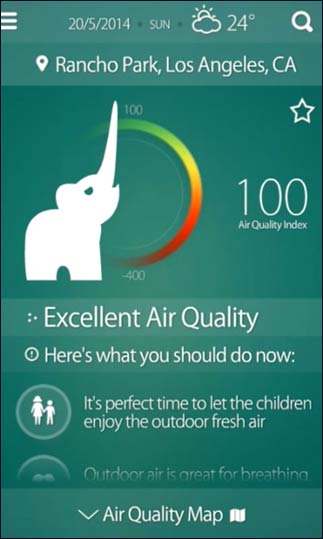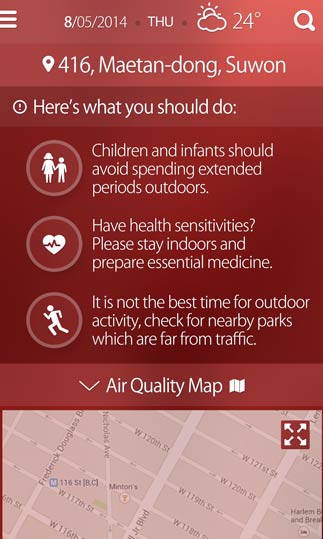By Ariel Blum
One day a year, air pollution levels in Israel drop dramatically, as much as 99 percent. That day is Yom Kippur, when traffic in Israel essentially ceases; even those who aren’t in synagogue on the Day of Atonement leave their cars at home to walk or bike the empty streets.
But how about the rest of the year? How is the air quality in your city or neighborhood? When is the pollution so high that you’d be better off indoors?
The answer is lurking on a new app from the Israeli startup BreezoMeter. The app, which is available for Android phones (with an iPhone version on its way) taps into the thousands of pollution monitoring stations around the world, then matches that data to your location using GPS, while customized algorithms factor in weather data, including wind direction and speed, to extrapolate the exact air quality for your specific location. The algorithms can often figure out air quality on a block-by-block basis.
All the data that BreezoMeter tracks is publicly available. But, says company co-founder Ziv Lautman, “it’s really scattered. So we have to send a lot of emails” to get to the right databases and access the appropriate feeds. Plus, the numbers don’t mean anything to most people. For example, a nitrogen oxide reading of “104 parts per billion” is mostly nonsensical to the layperson, but could mean serious trouble to one’s lungs.

The graphics make pollution “as fun as possible.” BreezoMeter converts the complex figures into a user-friendly visual of an elephant’s trunk, which points to a particular air-pollution number on a circular indicator loop. The loop changes color from green to yellow, to orange and to red. “We’re trying to make pollution fun -- as fun as possible, and not scary,” Lautman says.
This small startup – with four engineers plus founders Lautman, Korber and CTO Emil Fisher – has big plans. The app initially worked only in Israel, where there are 300 monitoring stations, but has recently been launched in the US . Europe and China are down the line. Some 90 countries around the world make their pollution data available.
A personal need
Ran Korber conceived the idea for BreezoMeter when he was looking to move. His wife was pregnant and suffered from asthma, so it was a priority to find a place where the air was clear. Korber and Lautman scoured existing websites but found that none had the kind of pollution rankings Korber and his growing family needed. BreezoMeter was built to address that personal, practical need.
BreezoMeter got its start as part of Jerusalem’s SifTech accelerator, which has been receiving a big push from the municipality and the Jerusalem Development Authority as they aim to transform the capital’s image into a startup center that can compete with Tel Aviv.
“It’s very exciting to be in Jerusalem these days. You can feel an entrepreneurial atmosphere developing,” Lautman notes.
The air for entrepreneurs may be hopping, but the air quality in Jerusalem is, surprisingly, not any better than muggy Tel Aviv. “The problem is the pollution from Tel Aviv comes right through the mountains towards the Jerusalem area,” says Lautman, who lives in a suburb of Jerusalem. “You look out at the hills and you imagine the rating will be green, but every day it’s the first place we get a notification of only medium air quality.
 The app gives the user specific useful information.
The app gives the user specific useful information.
While BreezoMeter today is a free app, the real money is in selling the formatted data to third parties. Real-estate sites, in particular, may be keen to grab a feed of BreezoMeter’s pollution readings. These sites already provide ancillary information about neighborhoods, from the quality of the schools to “walk ratings” indicating how close shops, restaurants and parks are and whether you need a car, bike or your own two feet to get to them. Adding pollution information represents an important added value.
As for the Yom Kippur index in Tel Aviv, Lautman warns that what you read in the news can be misleading. Nitrogen oxide is only one pollutant. But there’s another substance in the air – ozone – that is even more dangerous to human health. “And, unfortunately, on this past Yom Kippur, we saw very high levels of ozone in the air. So the air quality was actually not great at all,” Lautman says.
Did Lautman walk around on Yom Kippur with his company’s app open on his phone checking the levels around town? “Oh no, I try not to use my phone on Yom Kippur!” he says.